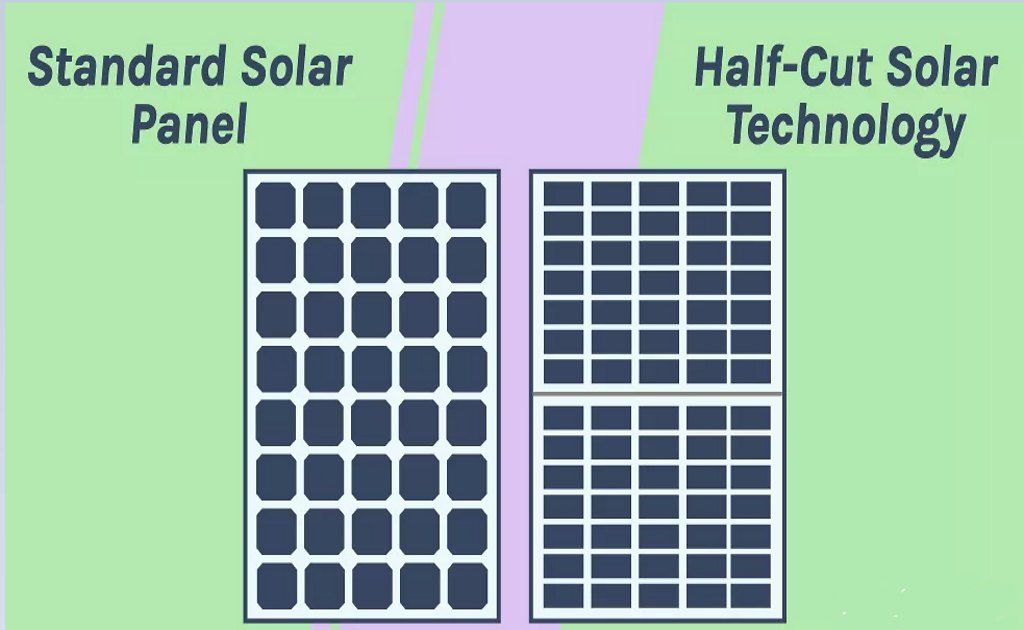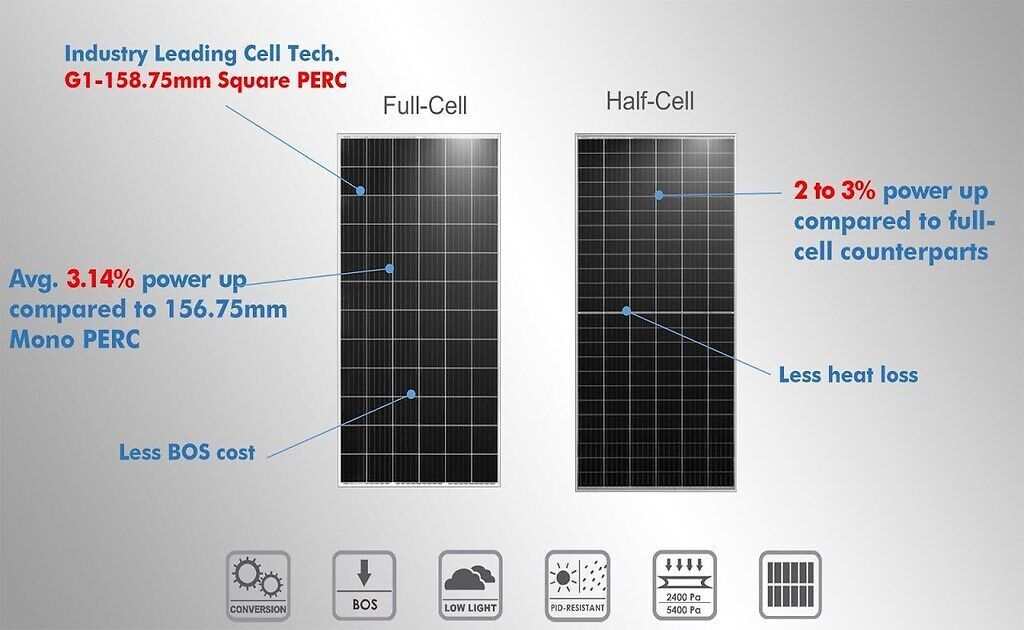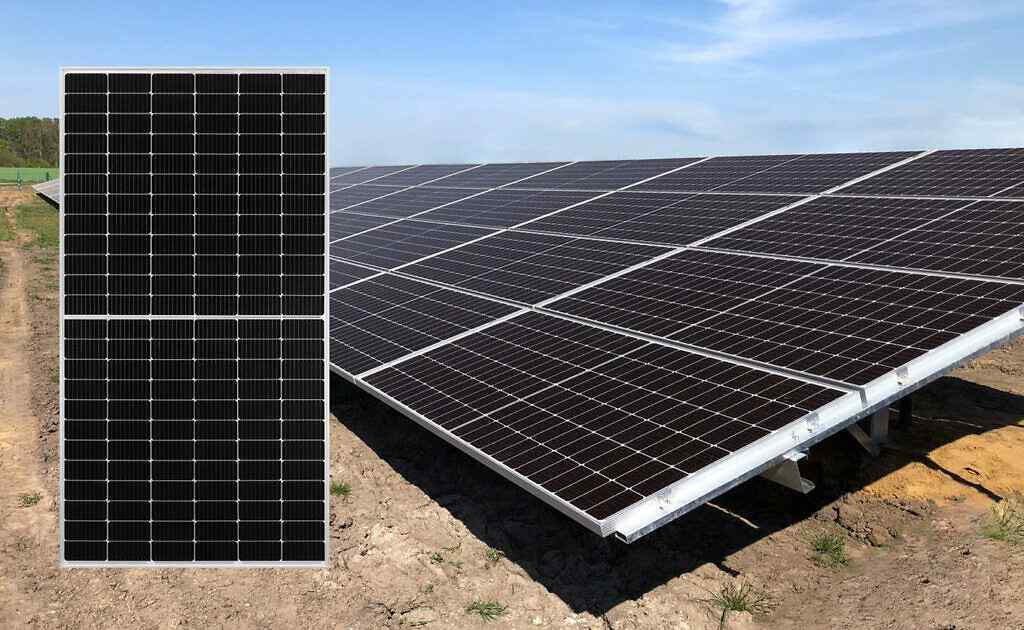Half-cut Solar Cells: What You Need to Know

What Are Half-cut Solar Cells?
REC Solar pioneered half-cut solar photovoltaic cells in 2014 with the goal of increasing the energy production of solar panels. Implementing half-cut cells in solar panels can enhance the power output of a solar panel system just as bifacial solar panels and PERC solar cells give slight boosts in the efficiencies of silicon solar panels. Half-cut solar cells are, as the name implies, typical silicon solar cells that have been sliced in half by a laser cutter.
Half-cut cells provide a number of advantages over standard solar cells. Most notably, half-cut solar cells outperform and last longer. In terms of performance, half-cut cells can boost panel efficiencies by a few percentage points. Furthermore, half-cut cells are more physically robust than their typical counterparts, because they are smaller in size, they are more resistant to breaking.
With these benefits, solar panels constructed with half-cut solar cells have the potential to give property owners installing solar energy systems shorter solar payback periods. Half-cut cells, particularly in installations where shade and restricted space are constraints, can make a solar panel installation even more worthwhile.
How Do Half-Cut Solar Cells Work?
Half-cut solar cell technology boosts the energy production of solar panels by lowering cell size, allowing more cells to fit on the panel. The panel is then divided in half so that the top runs independently of the bottom, generating more energy even if one part is shaded.
That’s the general overview - below, we break the process down.
Traditional monocrystalline solar panels typically feature 60 to 72 solar cells, therefore cutting those cells in half improves the number of cells. Half-cut panels typically feature 120 to 144 cells and are built with PERC technology, which provides improved module efficiency.
A laser is used to carefully chop the cells in half. By halving the current within the cells, resistive losses from transporting energy via current are decreased, resulting in improved performance. Because the solar cells are sliced in half and hence smaller in size, there are more cells on the panel than on regular panels. The panel is then divided in half so that the top and bottom halves act as two independent panels, producing electricity even if one half is shaded.
The key to half-cut cell design is a distinct form of panel "series wiring," or how the solar cells are linked together and send power through a bypass diode within a panel. The bypass diode, shown by the red line in the figures below, transports the power generated by the cells to the junction box.
When one cell in a conventional panel is shaded or defective and does not process energy, the entire row inside the series wiring stops providing power.
Half-Cut Solar Panel Vs Full Cell:

Traditional full cell panels (60 cells) are constructed with 60 or 72 cells per panel. A half-Cell module doubles the number of cells per panel to 120 or 144. The panel is the same size as a full cell panel but has twice the number of cells. By increasing the number of cells, this technique offers additional opportunities to capture solar energy and deliver it to the inverter.
Half-Cell technology is the technique of cutting cells in half to reduce resistance and boost efficiency. Traditional full cell panels with 60 or 72 cells generate resistance, reducing the panel's potential to generate additional power. Half-Cells with 120 or 144 cells have lower resistance, implying that more energy is collected and generated. Smaller cells on each half-cell panel lessen mechanical loads on the panel. The smaller the cell, the less likely the panel to micro fracture.
Furthermore, Half-Cell technology offers better power output ratings and is typically more dependable than regular full cell panels.
What Is A Mono PERC Half Cut Solar Panel?
Half-cut cell mono PERC solar modules feature solar cells that have been chopped in half, which increases the performance and endurance of the solar module. Traditional solar panels with 60 and 72 cells will contain 120 and 144 half-cut cells, respectively. When solar cells are cut in half, their current is likewise cut in half, lowering resistive losses and allowing the solar cells to produce more electricity.
Half-cut cells provide a number of advantages over standard solar cells. Most notably, half-cut solar cells outperform and last longer. In terms of performance, half-cut cells can boost panel efficiencies by a few percentage points. Furthermore, half-cut cells are more physically robust than their typical counterparts; because they are smaller in size, they are more resistant to breaking.
Smaller cells endure lower mechanical stresses, resulting in a lower chance of breaking. Half-cut cell PV modules outperform conventional solar panels in terms of production and dependability.
When compared to regular solar modules, new solar module generating technology has enhanced module output by up to 15 watts. With an efficiency of up to 19.79 percent.
The new solar module series, which is based on the newest trend of half cut cell technology, not only cuts the cells in half but also reduces the cost, resulting in a reduced LCOE.
What Are The Advantages Of Half-cut Solar Cells?
- They boost the power production and performance of solar modules because of their unique wiring arrangement, which allows them to tolerate more shadow. This implies that if your house has trees that cast shade on your roof at particular times of the day, your complete solar panel will not be rendered inoperable, as would a regular solar panel.
- Another advantage is that they often have a greater wattage than standard panels, up to 380 watts for the REC Alpha against traditional panels, which are normally in the 250-watt range, resulting in more electricity per square foot.
- Furthermore, the consequences of hot spots on your solar panels with half-cut cells are less severe. Hot spots are caused by the movement of surplus heat on a panel, such as from an extremely hot portion to a shaded, cooler section. Hot spots are less destructive in a half-cut cell since there are more cells to distribute the surplus heat to.
- By decreasing internal resistance, half-cut cells also minimize power loss seen by standard panels. Internal series resistance develops simply as a result of the nature of the energy going through the panel through electric current. However, when solar cells are chopped in half, less current is generated from each cell, resulting in lower resistive losses.
- Although half-cut cells have several advantages, they are more costly since they need additional soldering processes and laser cutting to create. Finally, you must consider whether the total benefits outweigh the extra expense.
How Do Half-Cut Solar Cells Improve Panel Performance?

Reduced resistive losses:
Resistive losses, or power lost during electrical current transit, are one form of power loss when solar cells convert sunlight into electricity. The tiny metal ribbons that traverse the surface of solar cells and connect them to nearby wires and cells transmit current, and transferring current via these ribbons results in some energy loss. Cutting solar cells in half reduces the current generated by each cell, and lesser current flowing results in fewer resistive losses when energy passes through cells and wires in a solar panel.
Higher Shade Tolerance:
Half-cut cells are more resistant to shading than regular solar cells. This is due to the wiring procedures used to link half-cut cells in a panel, rather than the cells being sliced in half. Traditional solar panels with complete cells are linked together in rows, which is known as series wiring. If one cell in a row is shaded and not producing energy, the entire row of cells will cease to produce electricity. Shade on one cell of one row would remove one-third of the power produced by a standard panel, which normally has three different rows of cells linked together.
Half-cut cells are likewise wired in series, but because panels built with half-cut cells have twice as many cells (120 instead of 60), there are twice as many independent rows of cells. Because a single shaded cell may only reduce a sixth of the total panel power output, panels made with half-cut cells lose less power when a single cell is shaded.
What Are The Disadvantages Of Half-cut Solar Cells?
High Cost of Manufacturing:
To produce the same amount of half-cut solar cell modules as whole-cell modules, producers must spend in doubling their tabber & stringers and purchasing cleaving equipment. According to studies, half-cell modules cost 0.6-1.2 percent more than whole-cell modules, however because of the increased power, their cost per watt is lowered by 0.8-1 percent.
Increased Probability of Cell-Inherent Defects:
Manufacturing half-cut solar cell modules implies twice as many soldered connections, which means twice as many faulty contacts. Cutting the solar cell in half increases the likelihood of producing faulty cells, which is a disadvantage of the technique for producers. While this is a concern, a producer with excellent quality control would not be adversely affected.
What Solar Panel Manufacturers Use Half-Cut Cells?
REC Solar introduced the first half-cut cell solar panels in 2014, and they have subsequently shifted the majority of their module manufacturing to be geared for half-cut cell manufacture. In addition to REC, various manufacturers have released half-cell modules. Half-cell panel alternatives are available from a number of big solar panel manufacturers, including Trina Solar, Hanwha Q CELLS, JinkoSolar, and LONGi Solar.
If you're interested in half-cut cell solar panels, consult with your installer to determine the best option for solar installation on your individual roof. Regardless of the choice you pick, standard vs half-cut, working with a reputable manufacturer and dependable local installers is your best bet.
Are Half-Cut Solar Panels Worth Your Investment?
Half-cut cells are excellent for increasing the energy yield of solar panels, but they are more difficult to manufacture. This makes switching to generating half-cell solar modules difficult for typical producers; it is not as simple as just adding half-cut cells to a production line.
Traditional solar panels can still be useful in many circumstances, such as if your roof receives plenty of sunshine throughout the day.
Half-cut cells, on the other hand, make sense if you need every ounce of energy you can get because you live in a remote area or want to maximize your net metering benefits. If you have a little surface area and require as much sun energy as possible, request half-cut cells. Otherwise, conventional panels should be enough, though you may want a few more on your roof that are created and plotted using solar panel design software.
Perhaps as the manufacture of half-cut cells gets more streamlined and simple to implement, they will become less expensive and more common. Your solar installer will assist you in determining if half-cut cells are the best option for your rooftop solar installation.

